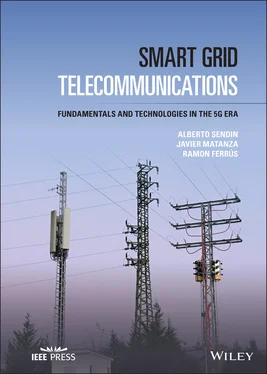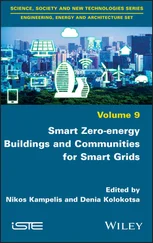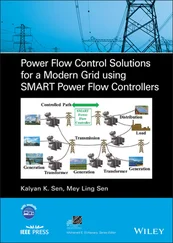Ramon Ferrús - Smart Grid Telecommunications
Здесь есть возможность читать онлайн «Ramon Ferrús - Smart Grid Telecommunications» — ознакомительный отрывок электронной книги совершенно бесплатно, а после прочтения отрывка купить полную версию. В некоторых случаях можно слушать аудио, скачать через торрент в формате fb2 и присутствует краткое содержание. Жанр: unrecognised, на английском языке. Описание произведения, (предисловие) а так же отзывы посетителей доступны на портале библиотеки ЛибКат.
- Название:Smart Grid Telecommunications
- Автор:
- Жанр:
- Год:неизвестен
- ISBN:нет данных
- Рейтинг книги:3 / 5. Голосов: 1
-
Избранное:Добавить в избранное
- Отзывы:
-
Ваша оценка:
- 60
- 1
- 2
- 3
- 4
- 5
Smart Grid Telecommunications: краткое содержание, описание и аннотация
Предлагаем к чтению аннотацию, описание, краткое содержание или предисловие (зависит от того, что написал сам автор книги «Smart Grid Telecommunications»). Если вы не нашли необходимую информацию о книге — напишите в комментариях, мы постараемся отыскать её.
Discover the foundations and main applications of telecommunications to smart grids Smart Grid Telecommunications,
Smart Grid Telecommunications
Smart Grid Telecommunications — читать онлайн ознакомительный отрывок
Ниже представлен текст книги, разбитый по страницам. Система сохранения места последней прочитанной страницы, позволяет с удобством читать онлайн бесплатно книгу «Smart Grid Telecommunications», без необходимости каждый раз заново искать на чём Вы остановились. Поставьте закладку, и сможете в любой момент перейти на страницу, на которой закончили чтение.
Интервал:
Закладка:
The book is organized in eight chapters.
Chapter 1provides a view of electric power systems and highlights the relevant aspects and main challenges that determine their evolution into the Smart Grid.
Chapter 2describes the key concepts and organization of telecommunication networks, systems, and services. It also introduces the fundamental aspects of key telecommunication media in Smart Grid (optical fiber, radio, and power lines).
Chapter 3goes deep, while keeping descriptive, into the telecommunications framework, and clarifies the foundational technology aspects of telecommunications (analog vs. digital, modulation, medium access, propagation, etc.).
Chapter 4focuses on data exchange, explaining and describing how telecommunication transport, switching, and routing functions work and are implemented in technologies used in Smart Grids.
Chapter 5provides a comprehensive view of the different Smart Grid domains, and specifically describes the Smart Grid services, together with the protocols and relevant standards applicable to them.
Chapter 6builds upon the optical fiber and the power lines, so important for utilities, to cover Passive Optical Networks and PLC technologies, with a focus on their role in the network access domain.
Chapter 7details wireless cellular 4G and 5G technologies. Being the flagship of the pervasive mobile communications service, this chapter addresses their baseline concepts to get an understanding of the complexity and capabilities of these technologies.
Chapter 8covers wireless IoT technologies, focusing on those that have an impact on Smart Grids. Zigbee, Wi‐SUN, LoRaWAN, Sigfox, LTE‐M, and NB‐IoT will be introduced.
Acronyms
10G‐EPON10 Gbps Ethernet Passive Optical Network1GFirst Generation2GSecond Generation3GThird Generation3GPPThird Generation4GFourth Generation5GFifth Generation5GC5G Core Network5GS5G System5QI5G QoS Identifier6GSixth Generation6LoWPANIPv6 Low Power Wireless Personal Area Network8PSK8‐Phase Shift KeyingACAlternating CurrentACBAccess Class BarringACKACKnowledgementADAAdvanced Distribution AutomationADMAdd–Drop MultiplexerADSLAsymmetric Digital Subscriber LineAESAdvanced Encryption StandardAMAmplitude ModulationAMFAccess and Mobility Management FunctionAMIAutomatic Metering InfrastructureAMRAdvanced Meter ReadingANSIAmerican National Standards InstituteAPCIApplication Protocol Control InformationAPDUApplication Protocol Data UnitAPIApplication Programming InterfaceAPNAccess Point NameAPONAsynchronous Transfer Mode Passive Optical NetworkAPTAsia Pacific TelecommunityARIBAssociation of Radio Industries and Business (Japan)ARPAddress Resolution ProtocolARQAutomatic Repeat reQuestASAIAverage Service Availability IndexASDUApplication Service Data UnitASIDIAverage System Interruption Duration IndexASIFIAverage System Interruption Frequency IndexASKAmplitude Shift KeyingASMGArab Spectrum Management GroupATISAlliance for Telecommunications Industry SolutionsATMAsynchronous Transfer ModeATUAfrican Telecommunications UnionAUSFAUthentication Server FunctionBCCHBroadcast Control CHannelBCHBroadcast CHannelBECBackward‐Error CorrectionBEMSBuilding Energy Management SystemBERBit Error RateBEVBattery EVBGPBorder Gateway ProtocolBLEBluetooth Low EnergyBNBase NodeBPLBroadband Power Line communicationsBPONBroadband Passive Optical Networkbpsbits per secondBPSKBinary Phase Shift KeyingC&ICommercial&IndustrialCAIDICustomer Average Interruption Duration IndexCAIFICustomer Average Interruption Frequency IndexCAPContention Access PeriodCAPEXCapital ExpenditureCAPIFCommon API FrameworkCBACost–Benefit AnalysisCBRSCitizens Broadband Radio ServiceCCComponent CarrierCCAClear Channel AssessmentCDMACode Division Multiple AccessCECoverage EnhancementCELIDCustomers Experiencing Long Interruption DurationsCEMInCustomers Experiencing Multiple Interruptions (n)CEMSMInCustomers Experiencing Multiple Sustained Interruption (n) and Momentary Interruption EventsCENEuropean Committee for Standardization (Comite Europeen de Normalisation)CENELECEuropean Committee for Electrotechnical Standardization (Comité Européen de Normalisation Electrotechnique)CEPTEuropean Conference of Postal and TelecommunicationsCFPContention‐Free PeriodCFSContention‐Free SlotCHCommunications HubCIGREConseil International des Grands Reseaux Electriques (International Council on Large Electric Systems)CIoTCellular Internet of ThingsCISPRComité International Spécial des Perturbations Radioélectriques (International Special Committee on Radio Interference)CITELComisión Interamericana de Telecomunicaciones (Inter‐American Telecommunication Commission)cMTCcritical Machine Type CommunicationsCNCore NetworkCoAPConstrained Application ProtocolCORESETControl Resource SetCOSEMCompanion Specification for Energy MeteringCPControl PlaneCPCyclic PrefixCPECustomer Premise EquipmentCP‐OFDMCyclic Prefix OFDMCPPCritical Peak PricingCPRCritical Peak RebatesCQIChannel Quality IndicatorCRCCyclic Redundancy CheckCRMCustomer Relationship ManagementCSDCircuit Switched DataCSIChannel State InformationCSMA/CACarrier Sense Multiple Access/Collision AvoidanceCSMA/CDCarrier Sense Multiple Access/Collision DetectionCSSChirp Spread SpectrumCTAIDICustomer Total Average Interruption Duration IndexCTSClear to SendCWDMCoarse Wavelength Division MultiplexingDADistribution AutomationDBADynamic Bandwidth AssignmentDCDirect CurrentDCData ConcentratorDCCData Communications CompanyDCIDownlink Control InformationDERDistributed Energy ResourcesD‐FACTSDistribution FACTSDFTDiscrete Fourier TransformDFT‐S‐OFDMDigital Fourier Transform Spread OFDMDGDistributed GenerationDLLData‐Link LayerDLMSDevice Language Message SpecificationDLRDynamic Line RatingDMDomain MasterDM‐RSDemodulation Reference SignalDMSDistribution Management SystemDMVPNDynamic Multipoint VPNDNData NetworkDNNData Network NameDNODistribution Network OperatorDNP3Distributed Network ProtocolDOEDepartment of Energy (USA)DRDemand ResponseDRBData Radio BearerDRXDiscontinuous ReceptionDSDistributed StorageDSBDouble SidebandDSMDemand‐Side ManagementDSMEDeterministic Synchronous Multichannel ExtensionDSODistribution System OperatorDSSDynamic Spectrum SharingDSSSDirect Sequence Spread SpectrumDWDMDense Wavelength Division MultiplexingEABExtended Access BarringECCElectronic Communications CommitteeECHONETEnergy Conservation and HOmecare NETworkEDEnd DeviceEDGEEnhanced Data rates for Global EvolutioneDRXextended Discontinuous ReceptioneMBBenhanced Mobile BroadbandEMCElectroMagnetic CompatibilityEMSEnergy Management SystemeMTC‐Uenhanced Machine Type Communications UnlicensedENEuropean Norm (Standard)eNBeNodeBEN‐DCE‐UTRAN NR Dual ConnectivityENISAEuropean Union Agency for Network and Information SecurityEPAEnhance Performance ArchitectureEPCEvolved Packet CoreEPONEthernet Passive Optical NetworkEPRIElectric Power Research InstituteEPSEvolved Packet SystemERPEnterprise Resource PlanningETSIEuropean Telecommunications Standards InstituteEUEuropean UnionE‐UTRANEnhanced UMTS Terrestrial Radio Access NetworkEVElectric VehicleEVCCElectric Vehicle Communication ControllerEVSEElectric Vehicle Supply EquipmentFACTSFlexible Alternating Current Transmission SystemFANField Area NetworkFCCFederal Communications CommissionFDDFrequency Division DuplexingFDIRFault Detection Isolation and RestorationFDMFrequency Division MultiplexingFDMAFrequency Division Multiple AccessFECForward Error CorrectionFERFrame Error RateFFDFull Function DeviceFFTFast Fourier TransformFHFrequency HoppingFLISRFault Location, Isolation, and Service RestorationFMFrequency ModulationFRFrequency RangeFSANFull Service Access NetworkFSKFrequency Shift KeyingFTTHFiber To The HomeFTTxFiber To The xGBGreat BritainGBRGuaranteed Bit RateGEMGPON Encapsulation MethodGFPGeneric Framing ProcedureGISGeographic Information SystemgNBgNodeBGOOSEGeneric Object‐Oriented Substation EventGPONGigabit Passive Optical NetworkGPRSGeneral Packet Radio ServiceGREGeneric Routing EncapsulationGSMGlobal System for MobileGSMAGSM AssociationGSSEGeneric Substation State EventGTCGPON Transmission ConvergenceGTPGPRS Tunneling ProtocolGTSGuaranteed Time SlotGWGateWayHANHome Area NetworkHARQHybrid Automatic Repeat RequestHD‐FDDHalf Duplex Frequency Division DuplexingHDRHigh Data RateHEMSHome Energy Management SystemHEVHybrid Electric VehicleHFCHybrid Fiber‐CoaxialHSPAHigh Speed Packet AccessHSSHome Subscriber ServerHVDCHigh Voltage Direct CurrentIANIndustrial Area NetworkICCPInter‐Control Center ProtocolICEInternal Combustion EngineICIInter‐Carrier InterferenceICICInter‐Cell Interference CoordinationICTInformation and Communication TechnologiesIDIDentifierIEDIntelligent Electronic DeviceIETFInternet Engineering Task ForceIGBTInsulated Gate Bipolar TransistorIHDIn‐Home DisplayIIoTIndustrial Internet of ThingsIMSIP Multimedia SubsystemIMTInternational Mobile TelecommunicationsIoTInternet of ThingsIPInternet ProtocolISDNIntegrated Services Digital NetworkISIInter‐Symbol InterferenceISMIndustrial, Scientific, and MedicalISOInternational Organization for StandardizationITU‐RITU Radiocommunication SectorkWhkiloWatt hourL2Layer 2L3Layer 3LAALicensed Assisted AccessLADNLocal Area Data NetworkLANLocal Area NetworkLASERLight Amplification by Stimulated Emission of RadiationLBTListen Before TalkLCASLink Capacity Adjustment SchemeLDLogical DeviceLDPLabel Distribution ProtocolLDPCLow‐Density Parity CheckLDRLow Data RateLEDLight Emitting DiodeLLIDLogical Link IDentificationLMRLand Mobile RadioLNLogical NodeLoSLine‐of‐SightLPWALow Power Wide AreaLPWANLow Power WANLR‐WPANLow‐Rate WPANLSPLabel Switched PathLTELong‐Term EvolutionLTE‐MLong‐Term Evolution for MachinesLwM2MLightweight Machine‐to‐MachineM2MMachine‐to‐MachineMACMedium Access ControlMAIFIMomentary Average Interruption Frequency IndexMAIFIEMomentary Average Interruption Event (E) Frequency IndexMANMetropolitan Area NetworkMAPMaximum A‐PosterioryMAPMedia Access PlanMCLMaximum Coupling LossMCSModulation and Coding SchemeMDMMeter Data ManagementMDMSMeter Data Management SystemMEDMajor Event DayMEFMetro Ethernet ForumMEMSMicrogrid Energy Management SystemMHDSMulti Hop Delivery ServiceMIBManagement Information BaseMIMOMultiple‐Input Multiple‐OutputMMEMobility Management EntitymMTCmassive Machine Type CommunicationsMNOMobile Network OperatorMPCPMulti‐Point MAC Control ProtocolMPLSMulti‐Protocol Label SwitchingMPLS‐TPMulti‐Protocol Label Switching‐Transport ProfileMQTTMessage Queuing Telemetry TransportMS‐SPRINGMultiplex Section‐Shared Protection RingMTCMachine Type CommunicationsMVNOMobile Virtual Network OperatorNASNon‐Access StratumNASPINorth American Synchrophasor InitiativeNATNetwork Address TranslationNB‐IoTNarrowBand IoTNB‐IoT‐UNB‐IoT UnlicensedNFNetwork FunctionNFVNetwork Function VirtualizationNG‐PON2Next Generation‐Passive Optical Network 2NG‐RANNext Generation Radio Access NetworkNHRPNext Hop Resolution ProtocolNICNetwork Interface CardNIDDNon‐IP Data DeliveryNISTNational Institute of Standards and Technology (USA)NMSNetwork Management SystemNOPNormally Open PointNPBCHNarrowband PBCHNPCWNormal Priority Contention WindowNPDCCHNarrowband PDCCHNPDSCHNarrowband PDSCHNPNNon‐Public NetworkNPSSNarrowband PSSNPUSCHNarrowband PUSCHNRNew RadioNR‐UNew Radio UnlicensedNSNetwork ServerNSANon‐Stand AloneNSSSNarrowband SSSNTNNon‐Terrestrial NetworkNTUNetwork Terminal UnitNWKNetworkOAMOperations, Administration, and MaintenanceOCOptical CarrierOChOptical ChannelODNOptical Data NetworkODNOptical Distribution NetworkODUOptical Data UnitOFCOMOffice of Communications (UK)OFDMOrthogonal Frequency Division MultiplexingOFDMAOrthogonal Frequency Division Multiple AccessOLTOptical Line TerminalONTOptical Network TerminalONUOptical Network UnitOPERAOpen PLC European Research AllianceOPEXOPerational EXpenditureOSIOpen System InterconnectionOSPFOpen Shortest Path FirstOTNOptical Transport NetworkOTUOptical Transport UnitOXCOptical Cross‐ConnectPAMPulse Amplitude ModulationPANPersonal Area NetworkPCCPoint of Common CouplingPCCHPaging Control CHannelPCFPolicy and Charging FunctionPCFICHPhysical Control Formal Indicator CHannelPcoProxy coordinatorPDCPhasor Data ConcentratorPDCCHPhysical Downlink Control CHannelPDHPlesiochronous Digital HierarchyPDNPacket Data NetworkPDSCHPhysical Downlink Shared CHannelPDUPacket Data UnitPEVPlug‐in Electric VehicleP‐GWPDN GatewayPHEVPlug‐in Hybrid Electric VehiclePHICHPhysical Hybrid ARQ Indicator CHannelPLCPPhysical Layer Convergence ProtocolPLMNPublic Land Mobile NetworkPMPhase ModulationPMRPrivate (or Professional) Mobile RadioPMUPhasor Measurement UnitPNI‐NPNPublic Network Integrated NPNPONPassive Optical NetworkPOTSPlain Old Telephone SystemPPDRPublic Protection and Disaster ReliefPRACHPhysical Random Access CHannelPRBPhysical Radio BlockPRIMEPoweRline for Intelligent Metering EvolutionPSPrimary SubstationPSKPhase Shift KeyingPSMPower Save ModePSSPrimary Synchronization SignalPSTNPublic Switched Telephone NetworkPTTPush‐To‐TalkPUCCHPhysical Uplink Control CHannelPUSCHPhysical Uplink Shared CHannelQAMQuadrature Amplitude ModulationQoSQuality of ServiceQPSKQuadrature Phase Shift KeyingRACDSResilient AC Distribution SystemRANRadio Access NetworkRCCRegional Commonwealth in the field of CommunicationsRESTREpresentational State TransferRFRadio FrequencyRFCRequest For CommentsRFDReduced Function DeviceRIPRouting Information ProtocolRLCRadio Link Controlrmsroot mean squareROADMReconfigurable Optical Add‐Drop MultiplexerRPLRouting Protocol for Low Power and Lossy NetworksRRRadio RegulationsRRCRadio Resource ControlRRMRadio Resource ManagementRSRepeating StationRTPReal‐Time PricingRTSReady to SendRTTRound‐Trip TimeRTURemote Terminal UnitSASubstation AutomationSAStand‐AloneSAESociety of Automotive EngineersSAIDISystem Average Interruption Duration IndexSAIFISystem Average Interruption Frequency IndexSARSegmentation and ReassemblingSBAService‐Based ArchitectureSCADASupervisory Control and Data AcquisitionSCEFService Capability Exposure FunctionSC‐FDMASingle Carrier FDMASCLSubstation Configuration LanguageSCPShared Contention PeriodSDHSynchronous Digital HierarchySDNSoftware Defined NetworkingSEPSmart Energy ProfileSFSpreading FactorS‐GWServing GatewaySIMSubscriber Identity ModuleSLAService‐Level AgreementSMSShort Message ServiceSMWANSmart Metering WANSNService NodeSNPNStandalone NPNSNRSignal‐to‐Noise RatioS‐NSSAISingle Network Slice Selection Assistance InformationSONETSynchronous Optical NETworkSRBSignalling Radio BearerSRSSounding Reference SignalSSSecondary SubstationSSBSynchronization Signal BlockSSSSecondary Synchronization SignalSSTSlice/Service TypeSTATCOMSTATic COMpensatorSTMSynchronous Transport ModuleSTPSpanning Tree ProtocolSTSSynchronous Transport SignalSVSampled ValueTATracking AreaTASETelecontrol Application and Service ElementTAUTracking Area UpdateTBTransport BlockTBCCTail‐Biting Convolutional CodeTCTechnical CommitteeTCPTransmission Control ProtocolTDDTime Division DuplexingTDMTime Division MultiplexingTDMATime Division Multiple AccessTETRATERrestrial Trunked RAdioTIATelecommunications Industry AssociationTRTechnical ReportTSTechnical SpecificationTSCTime‐Sensitive CommunicationsTSCHTime‐Slotted Channel HoppingTSNTime‐Sensitive NetworkingTSPTelecommunication Service ProviderTTITransmission Time IntervalTWDMTime and Wavelength Division MultiplexingUCCUtility Control CenterUCIUplink Control InformationUDMUnified Data ManagementUDPUser Datagram ProtocolUHFUltrahigh FrequencyUMTSUniversal Mobile Telecommunications SystemUNBUltra NarrowbandUPFUser Plane FunctionURLLCUltra Reliable Low‐Latency CommunicationsUTCUtilities Technology CouncilV2XVehicle‐to‐everythingVCVirtual ContainerVCATVirtual ConcatenationVHFVery High FrequencyVoLTEVoice over LTEVPNVirtual Private NetworkWADMWavelength Add‐Drop MultiplexerWAMSWide‐Area Measurement/Monitoring SystemWANWide Area NetworkWDMWavelength Division MultiplexingWi‐FiWireless‐FidelityWPANWireless Personal Area NetworkWRCWorld Radiocommunication ConferencexDSLx Digital Subscriber Line (covering various types of DSL)XG‐PONX (10) Gbps Passive Optical NetworkXGS‐PONX (10) Gbps Symmetrical Passive Optical Network
Читать дальшеИнтервал:
Закладка:
Похожие книги на «Smart Grid Telecommunications»
Представляем Вашему вниманию похожие книги на «Smart Grid Telecommunications» списком для выбора. Мы отобрали схожую по названию и смыслу литературу в надежде предоставить читателям больше вариантов отыскать новые, интересные, ещё непрочитанные произведения.
Обсуждение, отзывы о книге «Smart Grid Telecommunications» и просто собственные мнения читателей. Оставьте ваши комментарии, напишите, что Вы думаете о произведении, его смысле или главных героях. Укажите что конкретно понравилось, а что нет, и почему Вы так считаете.












